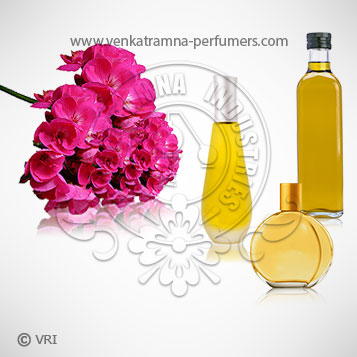
| Botanical Name | Pelargoneum graveolens |
| Common Name | Cranesbills |
| Country of Origin | South Africa |
| Solubility | Soluble in alcohol and oils. Insoluble in water |
| Specific Gravity | 0.8900 |
| Optical Rotation | (-30.0) – (-7.0) @ 20°C |
| Refrective Index | 1.461 – 1.475 @ 20°C |
| PlantPart | Leaves |
| Bland With | This essential oil blends well with other oils such as angelica, basil, bergamot, carrot seed, cedarwood, citronella, clary sage, grapefruit, jasmine, lavender, lime, neroli, orange and rosemary. |
| CAS No | 8000-46-2 |
| Flash Point | 185°F |
| Extraction Method | Supercritical CO2 Extraction |
The geranium oil has a strong smell with a floral aroma and a hint of mint. It is extracted from the plant Pelargonium odorantissimum, of the Geraniaceae family. The oil is extracted through CO2 extraction process from the leaves and stalks of the plants.
The Geranium plants originated from South Africa as well as Reunion, Madagascar, Egypt and Morocco and were introduced to European countries such as Italy, Spain and France in the 17th century. There are over 200 species of geranium, some scented and some not
Color : Pale yellow to greenish yellow liquid with Characteristic minty, rosy-like odor,
Aroma : It is often confused with rose oil due to its rose-like fragrance.
It composed of various constituents that include a-pinene, myrcene, limonene, menthone, linalool, geranyl acetate, citronellol, geraniol and geranyl butyrate.
Known for its therapeutic properties, this geranium oil is used to help in the treatment of acne, bruises, burns, cuts, dermatitis, eczema, hemorrhoids, sore throat, tonsillitis, PMS, menopausal problems, stress and neuralgia.